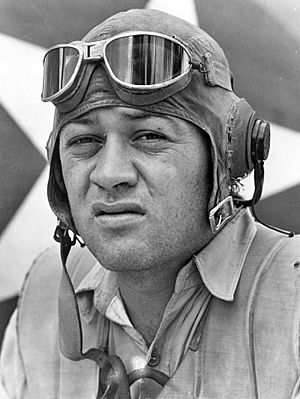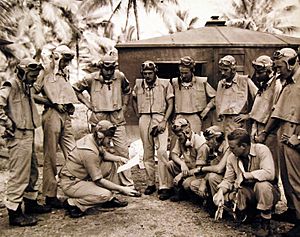Pappy Boyington facts for kids
Quick facts for kids
Pappy Boyington
|
|
|---|---|

Major Gregory "Pappy" Boyington during World War II
|
|
| Birth name | Gregory Boyington |
| Other name(s) | Gregory Hallenbeck |
| Nickname(s) | "Pappy", "Gramps" |
| Born | December 4, 1912 Coeur d'Alene, Idaho, United States |
| Died | January 11, 1988 (aged 75) Fresno, California, United States |
| Buried | |
| Allegiance |
|
| Service/ |
|
| Years of service | 1934–1947 |
| Rank | Colonel |
| Commands held |
|
| Battles/wars | |
| Awards | |
| Other work | Boeing – draftsman and engineer |
Gregory "Pappy" Boyington (born December 4, 1912 – died January 11, 1988) was a brave American combat pilot. He was a top United States Marine Corps pilot, known as a flying ace, during World War II. He earned two very important awards: the Medal of Honor and the Navy Cross.
In 1941, Boyington was a Marine pilot in the Pacific. He then joined the famous "Flying Tigers" in China. He fought in Burma against Japan in 1941 and 1942.
In 1942, Boyington rejoined the Marine Corps. He flew combat missions in the F4U Corsair fighter plane. In September 1943, he led a squadron called VMF-214, also known as the "Black Sheep." In January 1944, he was shot down by Japanese planes. He was captured and held as a prisoner of war for over a year. He was freed when Japan surrendered. A TV show called Baa Baa Black Sheep was made about him and his squadron.
Contents
Early Life and Education
Gregory Boyington was born on December 4, 1912, in Coeur d'Alene, Idaho. When he was three, his family moved to St. Maries. He lived there until he was twelve. He was part Brulé Sioux. Later, he moved to Tacoma, Washington. There, he became a wrestler at Lincoln High School. He had his first airplane ride at age six. The pilot was Clyde Pangborn, who later flew non-stop across the Pacific Ocean.
After high school in 1930, Boyington went to the University of Washington in Seattle. He joined the Army ROTC program. He was also on the university's wrestling and swimming teams. For a while, he was the middleweight wrestling champion of the Pacific Northwest. He worked in mining and logging camps during his summers. In 1934, he graduated with a degree in aeronautical engineering. After college, he worked for Boeing as a draftsman and engineer.
Military Career Begins
Boyington started his military training in college with the Army ROTC. In June 1934, he became a second lieutenant in the U.S. Army Coast Artillery Reserve. He served for two months at Fort Worden, Washington.
In 1935, he wanted to join flight training. But he learned that married men were not allowed. Boyington had grown up as Gregory Hallenbeck, thinking his stepfather was his father. When he got his birth certificate, he found out his real father was Charles Boyington. Since there was no record of a Gregory Boyington being married, he joined the U.S. Marine Corps as an aviation cadet using his birth name.
Joining the Marines
On February 18, 1936, Boyington became a Marine Corps Reserve aviation cadet. He went to Naval Air Station Pensacola for flight training. He became a Naval Aviator on March 11, 1937. He then joined Aircraft One, Fleet Marine Force. On July 2, 1937, he became a second lieutenant in the regular Marine Corps.
From 1938 to 1939, Boyington attended The Basic School in Philadelphia. After that, he joined the 2nd Marine Aircraft Group in San Diego Naval Air Station. He took part in training exercises from aircraft carriers like the USS Lexington. In November 1940, he was promoted to first lieutenant. He then became an instructor at Pensacola.
The Flying Tigers
On August 26, 1941, Boyington left the Marine Corps. He joined a civilian company called CAMCO. This company hired pilots to defend China and the Burma Road. This group became known as the famous Flying Tigers in Burma. Boyington became a flight leader with the Tigers. He was officially credited with shooting down two Japanese planes in the air and damaging 1.5 on the ground. In April 1942, he left the Flying Tigers and returned to the United States.
Back with the Marine Corps
On September 29, 1942, Boyington rejoined the Marine Corps as a major. The Marine Corps needed experienced pilots. In early 1943, he went to the South Pacific. He served as an executive officer for Marine Fighter Attack Squadron 122 (VMFA-122). From July to August 1943, he commanded Marine Fighter Attack Squadron 112.
In September 1943, he became the leader of Marine Fighter Squadron 214 (VMF-214). This squadron became famous as the "Black Sheep Squadron." Boyington earned the nickname "Pappy" because he was 31 years old. This was about ten years older than most of the pilots under him. War reporters picked up the nickname "Pappy."
Boyington is best known for his amazing flights in the Vought F4U Corsair with VMF-214. He shot down 14 enemy planes in just 32 days. By December 27, 1943, he had shot down 25 enemy planes.
One famous event was his attack on Kahili airdrome on October 17, 1943. Boyington and 24 fighters flew over the airfield, where 60 enemy planes were based. They dared the enemy to send up their planes. In the fierce battle, 20 enemy planes were shot down. All the Black Sheep pilots returned safely. Boyington's squadron, flying from Vella Lavella island, even offered to shoot down a Japanese Zero for every baseball cap sent to them by major league players. They received 20 caps and shot down even more enemy planes!
On January 3, 1944, he matched World War I ace Eddie Rickenbacker's record of 26 enemy planes destroyed. On that mission, 48 American fighters, including four from the Black Sheep Squadron, flew over Rabaul. Boyington was seen shooting down his 26th plane. But then he got caught in a big dogfight and was not seen again. Boyington's wingman, Captain George Ashmun, was killed.
Prisoner of War
After a long search, Boyington was declared missing in action (MIA). He had been picked up on January 3, 1944, by a Japanese submarine. He was taken to Rabaul and became a prisoner of war. He spent about 20 months in Japanese prison camps. He was held at Rabaul, then Truk, and finally at Ōmori Prison Camp near Tokyo. During this time, he was promoted to lieutenant colonel.
On August 29, 1945, after the atomic bombs and Japan's surrender, Boyington was freed. He returned to the United States on September 12, 1945. He was met by 21 former squadron members.
After the War
Soon after returning, Boyington went to Washington, D.C. to receive the Medal of Honor. This is the nation's highest military award. President Franklin D. Roosevelt had awarded it to him in March 1944. On October 4, 1945, Boyington also received the Navy Cross. The next day, he received his Medal of Honor from President Harry S. Truman at the White House.
After receiving his medals, Boyington went on a "Victory Bond Tour." He retired from the Marine Corps on August 1, 1947. Because of his brave service in combat, he was promoted to colonel.
Later Life and Legacy
Boyington was known as a tough and unique person. After the war, he worked different jobs, including refereeing professional wrestling matches.
Author and TV Show
Boyington wrote his autobiography, Baa Baa Black Sheep, in 1958. He also wrote a novel called Tonya.
Many people know about him from the 1970s TV show Baa Baa Black Sheep. This drama was loosely based on Boyington's book and his squadron. Actor Robert Conrad played Boyington. Boyington himself even had small roles in a few episodes as a visiting general.
Many of Boyington's former pilots were upset about the show. They said it was mostly made-up and showed a too-glamorous version of Boyington. Boyington often told interviewers that the show was "hogwash and Hollywood hokum."
Public Appearances
Paintings and photos often show Boyington with an aircraft named "LuluBelle" covered in victory flags. However, he rarely flew the same plane more than a few times in combat. He reportedly chose the F4U in the worst condition. This was so his pilots wouldn't be afraid to fly their own planes.
In 1981, Boyington attended a Black Sheep reunion in Washington, D.C. It was held at the Smithsonian Institution's National Air and Space Museum. The reunion was for the dedication of a restored F4U-1 Corsair plane. Boyington climbed into the cockpit for photos. He confirmed the cockpit was accurate and said, "Yeah, I could fly it today, if it was airworthy." He even signed the Corsair. This plane now hangs from the ceiling at the museum's Dulles Airport Annex.
Boyington also appeared on TV shows like To Tell the Truth in 1957 and The Today Show in 1976.
Family Life
Boyington had three children with his first wife, Helen Clark. His daughter, Janet, passed away. His son, Gregory Boyington, Jr., became a lieutenant colonel in the U.S. Air Force. His youngest child was Gloria.
Boyington was married four times. His last marriage was to Josephine Wilson Moseman in 1978.
Death and Burial
Gregory Boyington was a heavy smoker for most of his life. He died of lung cancer on January 11, 1988, at age 75, in Fresno, California. He is buried at Arlington National Cemetery. His burial included full military honors, with a special "missing man fly-by" by Marine F-4 Phantom II jets.
Military Awards and Honors
Boyington received many military awards:
 |
|||
| Naval Aviator insignia | ||||
| Medal of Honor | Navy Cross | Purple Heart Medal | ||
| Presidential Unit Citation with a bronze star | Prisoner of War Medal | American Defense Service Medal with a bronze star | ||
| American Campaign Medal | Asiatic-Pacific Campaign Medal with a silver star | World War II Victory Medal | ||
Personal Honors and Memorials
Airport Renamed
In August 2007, the Coeur d'Alene Airport was renamed "Coeur d'Alene Airport–Pappy Boyington Field" in his honor. A documentary film called Pappy Boyington Field was made about the effort to rename the airport.
University of Washington Memorial
In 2006, students at the University of Washington (Boyington's college) voted to create a memorial. This memorial honors all eight university alumni who received the Medal of Honor. It was completed in November 2009.
Boyington was added to the Naval Aviation Hall of Honor in 1994. This is located at the National Naval Aviation Museum in Pensacola, Florida.
NROL-82 Mission Patch
Boyington was the inspiration for the NROL-82 mission patch. This patch, launched in April 2021, shows "GPB" (Gregory Pappy Boyington) and an F4U Corsair.
National Aviation Hall of Fame
In 2019, Boyington was inducted into The National Aviation Hall of Fame in Dayton, Ohio.
See also
 In Spanish: Gregory "Pappy" Boyington para niños
In Spanish: Gregory "Pappy" Boyington para niños
- List of historic United States Marines
- List of Medal of Honor recipients
- List of Medal of Honor recipients for World War II
- List of military figures by nickname






